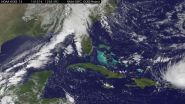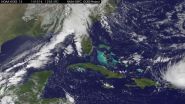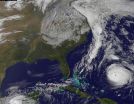(Press-News.org) VIDEO:
NOAA's GOES-East satellite captured this image of Hurricane Gonzalo off the U.S. East Coast on Oct. 16 at 13:07 UTC (9:07 a.m. EDT).
Click here for more information.
NASA and NOAA satellites have been providing continuous coverage of Hurricane Gonzalo as it moves toward Bermuda. NASA's Terra satellite saw thunderstorms wrapped tightly around the center with large bands of thunderstorms wrapping into it. NOAA's GOES-East satellite provided and "eye-opening" view of Gonzalo, still a Category 4 hurricane on Oct. 16.
A hurricane warning is in effect for Bermuda and that means that hurricane conditions are expected within the warning area, meaning the entire island.
On Oct. 15 at 15:30 UTC (11:30 a.m. EDT) the Moderate Resolution Imaging Spectroradiometer or MODIS instrument aboard NASA's Terra satellite captured a visible picture of Hurricane Gonzalo in the Atlantic Ocean. The image revealed a cloud-covered center with strong thunderstorms surrounding the eye as bands of strong thunderstorms in the southern, eastern and northern quadrants spiraled into the center.
NOAA's GOES-East satellite captured an image of Hurricane Gonzalo off the U.S. East Coast on Oct. 16 at 13:07 UTC (9:07 a.m. EDT) and showed that Gonzalo's eye had become cloud-free. The image also showed a line of clouds associated with a cold front stretching over 1,600 miles that just moved off the U.S. East coast and headed toward Gonzalo.
On Thursday, Oct. 16 at 8 a.m. EDT, Hurricane Gonzalo was still a major hurricane with maximum sustained winds near 140 mph (220 kph). Hurricane force winds extend outward up to 45 miles (75 km) from the center and tropical storm force winds extend outward up to 150 miles (240 km).
Fluctuations in intensity are common in major hurricanes. The National Hurricane Center (NHC) cautioned that "Slow weakening is forecast but Gonzalo is expected to be a dangerous hurricane when it moves near Bermuda."
Gonzalo's eye was located by a NOAA Hurricane Hunter near latitude 25.5 north and longitude 68.7 west. That puts the eye of Gonzalo about 525 miles (845 km) south-southwest of Bermuda. The minimum central pressure measured by the NOAA Hurricane Hunter aircraft is 940 millibars.
Gonzalo is moving toward the north near 9 mph (15 kph) and this general motion is expected to continue today. The NHC forecast calls for a turn toward the north-northeast and an increase in forward speed tonight (Oct. 16) and Friday (Oct. 17). On the forecast track, the center of Gonzalo is expected to pass near Bermuda on Friday.
The NHC expects hurricane-force winds, and rainfall totals of 3 to 6 inches in Bermuda. A storm surge with coastal flooding can be expected in Bermuda, with large and destructive waves along the coast. In addition, life-threatening surf and riptide conditions are likely in the Virgin Islands, Puerto Rico, Dominican Republic, Bahamas. Those dangerous conditions are expected along the U.S. East Coast and Bermuda later today, Oct. 16.
The NHC forecast calls for Gonzalo to remain a major hurricane on its approach to landfall in Bermuda. For updated information and forecasts, visit: http://www.nhc.noaa.gov.
INFORMATION:
Rob Gutro
NASA's Goddard Space Flight Center
Tropical Storm Ana continued on a path to the Hawaiian Islands as NASA's Terra satellite passed overhead and gathered data on the storm. NOAA's GOES-West satellite data was compiled into a movie that showed the intensification and movement of Ana. Watches are now in effect for Hawaii.
NOAA's Central Pacific Hurricane Center (CPHC) has issued a Tropical Storm Watch for Hawaii County, Hawaii. A tropical storm watch means that tropical storm conditions are possible within the watch area, in this case within 36 to 48 hours. Life-threatening surf and riptide conditions will ...
An international team of scientists has succeeded in explaining the formation and propagation over astronomical distances of jets of matter emitted by young stars—one of the most fascinating mysteries of modern astronomy. Using a patented experimental device and large-scale numerical simulations, the team obtained data consistent with astrophysical observations. The results of this research—just published in the prestigious journal Science—open up new opportunities for studying the role of magnetic fields in astrophysics and thermonuclear fusion. Bruno ...
Why is the Sun's million-degree corona, or outermost atmosphere, so much hotter than the Sun's surface? This question has baffled astronomers for decades. Today, a team led by Paola Testa of the Harvard-Smithsonian Center for Astrophysics (CfA) is presenting new clues to the mystery of coronal heating using observations from the recently launched Interface Region Imaging Spectrograph (IRIS). The team finds that miniature solar flares called "nanoflares" - and the speedy electrons they produce - might partly be the source of that heat, at least in some of the hottest parts ...
Researchers at the University of Connecticut have found a new way to identify protein mutations in cancer cells. The novel method is being used to develop personalized vaccines to treat patients with ovarian cancer.
"This has the potential to dramatically change how we treat cancer," says Dr. Pramod Srivastava, director of the Carole and Ray Neag Comprehensive Cancer Center at UConn Health and one of the principal investigators on the study. "This research will serve as the basis for the first ever genomics-driven personalized medicine clinical trial in immunotherapy ...
Antibiotic-resistant bacteria can share resources to cause chronic infections, Vanderbilt University investigators have discovered. Like the individual members of a gang who might be relatively harmless alone, they turn deadly when they get together with their "friends."
The findings, reported Oct. 8 in Cell Host & Microbe, shed light on a long-standing question in infectious diseases and may inform new treatment strategies, said Eric Skaar, Ph.D., MPH, Ernest W. Goodpasture Professor of Pathology, Microbiology and Immunology.
One way that Staphylococcus aureus and other ...
Using the NASA/ESA Hubble Space Telescope astronomers have made what may be the most reliable distance measurement yet of an object that existed in the Universe's formative years. The galaxy is one of the faintest, smallest and most distant galaxies ever seen and measuring its distance with this accuracy was possible due only to the incredibly detailed mapping of how giant galaxy clusters warp the space-time around them.
Astronomers often use gravitational lensing -- the magnifying power of galaxy clusters -- to find distant galaxies [1]. However, when it comes to the ...
Boulder, Colo., USA - What is the "Sixth Extinction"? How do paleontologists determine North America's future fire threats? What do trilobites look like on the inside? Did the Chicxulub impact trigger an eruption? Here, the Paleontological Society highlights some of the best science and current work in paleontology to be presented at the 126th Annual Meeting of The Geological Society of America on 19-22 October in Vancouver, BC, Canada.
SUNDAY, 18 Oct.
Geospatial Analysis of Human-Megafaunal Overlap in North America: Lead author Meaghan Emery and colleagues write that ...
Organisms ranging from bacteria to humans have circadian clocks to help them synchronize their biological activities to the time of day. A study published by Cell Press October 16th in Cell now reveals that gut microbes in mice and humans have circadian rhythms that are controlled by the biological clock of the host in which they reside. Disruption of the circadian clock in the host alters the rhythms and composition of the microbial community, leading to obesity and metabolic problems.
"These findings provide an explanation for a long-standing and mysterious observation, ...
Supplementing the diet with omega-6 polyunsaturated fatty acids has beneficial effects on heart health by lowering "bad" LDL cholesterol and raising "good" HDL cholesterol, but the underlying mechanisms involved are poorly understood. Now research based on the genetic information from over 100,000 individuals of European ancestry has uncovered a gene that affects blood cholesterol levels through the generation of a compound from omega-6 polyunsaturated fatty acids, called lipoxins. The study, publishing online October 16 in the Cell Press journal Cell Metabolism, also provides ...
Researchers have found that male and female brains respond in remarkably different ways to high-fat meals. Those differences in the brain lead to greater inflammation and increased health risks in males that indulge on fatty foods in comparison to females, a new study in mice shows. The findings reported in the Cell Press journal Cell Reports on October 16th may help to explain observed differences in obesity outcomes between women and men – premenopausal women carrying extra weight fare better than men do – and suggest that dietary advice should be made more ...




